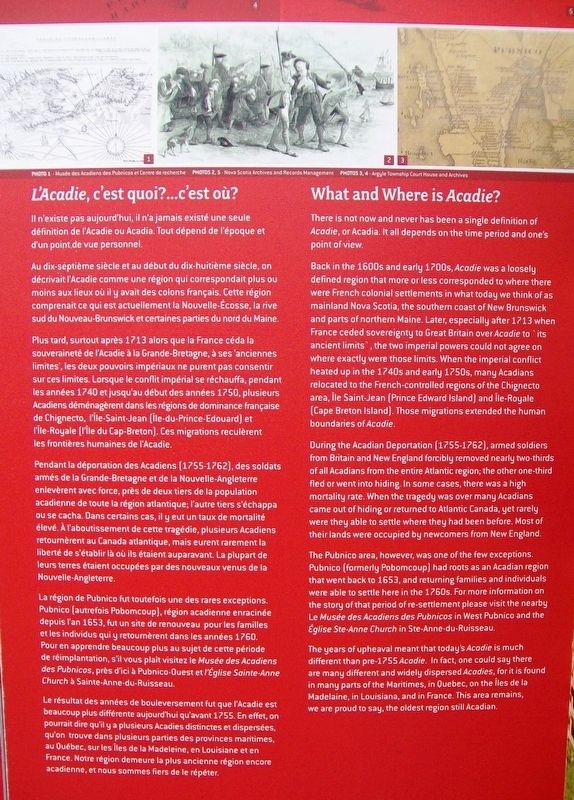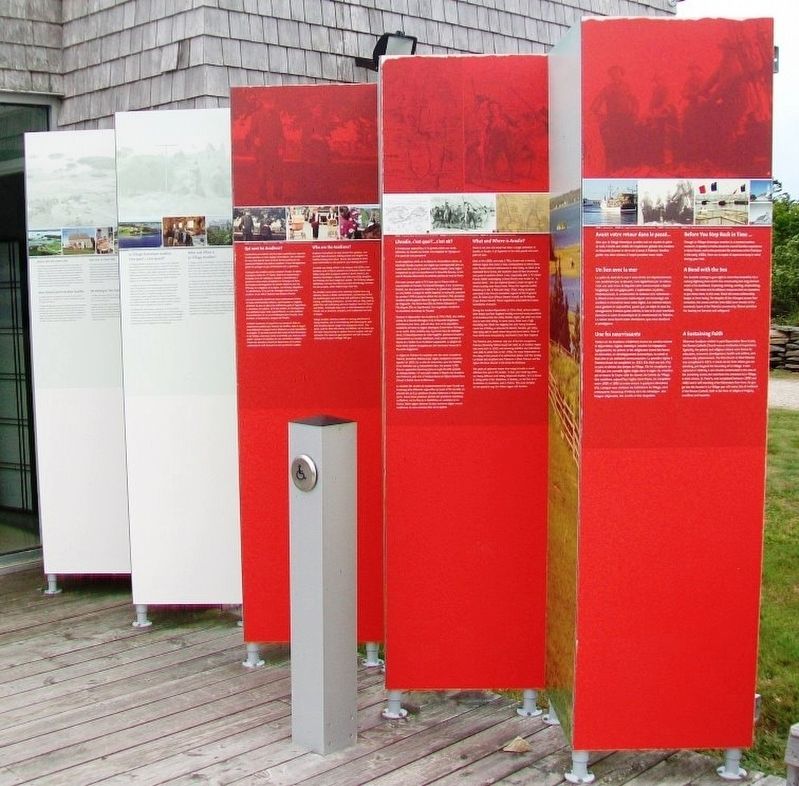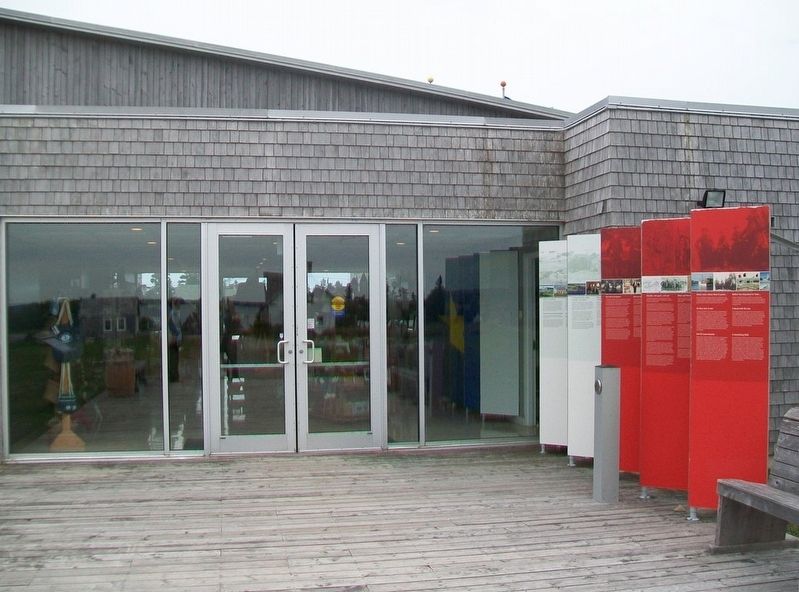What and Where is Acadie? / L'Acadie, c'est quoi?...c'est ou?
There is not now and never has been a single definition of Acadie, or Acadia. It all depends on the time period and one's point of view.
Back in the 1600s and early 1700s, Acadie was a loosely defined region that more or less corresponded to where there were French colonial settlements in what today we think of as mainland Nova Scotia, the southern coast of New Brunswick and parts of northern Maine. Later, especially after 1713 when France ceded sovereignty to Great Britain over Acadie to 'its ancient limits', the two imperial powers could not agree on where exactly were those limits. When the imperial conflict heated up in the 1740s and early 1750s, many Acadians relocated to the French-controlled regions of the Chignecto area, Île Saint-Jean (Prince Edward Island) and Île-Royale (Cape Breton Island). Those migrations extended the human boundaries of Acadie.
During the Acadian Deportation (1755-1762), armed soldiers from Britain and New England forcibly removed nearly two-thirds of all Acadians from the entire Atlantic region; the other one-third fled or went into hiding. In some cases, there was a high
mortality rate. When the tragedy was over many Acadians came out of hiding or returned to Atlantic Canada, yet rarely were they able to settle where they had been before. Most of their lands were occupied by newcomers from New England.The Pubnico area, however, was one of the few exceptions. Pubnico (formerly Pobomcoup) had roots as an Acadian region that went back to 1653, and returning families and individuals were able to settle here in the 1760s. For more information on the story of that period of re-settlement please visit the nearby Le Musée des Acadiens des Pubnicos in West Pubnico and the Église Ste-Anne Church in Ste-Anne-du-Ruisseau.
The years of upheaval meant that today's Acadie is much different than pre-1755 Acadie. In fact, one could say there are many different and widely dispersed Acadies, for it is found in many parts of the Maritimes, in Quebec, on the Îles de la Madelaine, in Louisiana, and in France. This area remains, we are proud to say, the oldest region still Acadian.
Au dix-septième siècle et au début du dix-huitième siècle, on décrivait l'Acadie comme une région qui correspondait plus ou moins aux lieux où il y avait des colons française. Cette
Plus tard, surtout après 1713 alors que la France céda la souveraineté de l'Acadie à la Grande-Bretagne, à ses 'anciennes limites', les deux pouvoirs impériaux ne purent pas consentir sur ces limites. Lorsque le conflit impérial se réchauffa, pendant les années 1740 et jusqu'au début des années 1750, plusieurs Acadiens déménagèrent dans les régions de dominance française de Chignecto, l'Île-Saint-Jean (Île-du-Prince-Edouard) et l'Île-Royale (l'Île du Cap-Breton). Ces migrations reculèrent les frontières humaines de l'Acadie.
Pendant la déportation des Acadiens (1755-1762), des soldats armés de la Grande-Bretagne et de la Nouvelle-Angleterre enlevèrent avec force, près de deux tiers de la population acadienne de toute le région atlantique; l'autre tiers s'échappa ou se cacha. Dans certains cas, il y eut un taux de mortalité élevé. À l'aboutissement de cette tragédie, plusieurs Acadiens retournèrent au Canada atlantique, mais eurent rarement la liberté de s'établir là où ils étaient auparavant. La plupart de leurs terres étaient occupées par des nouveaux venus de la Nouvelle-Angleterre.
La région de Pubnico fut toutefois une des rares exceptions. Pubnico (autrefois Pobomcoup), région acadienne enracinée depuis l'an 1653, fut un site de
Le résultat des années de bouleversement fut que l'Acadie est beaucoup plus différente aujourd'hui qu'avant 1755. En effet, on pourrait dire qu'il y a plusieurs Acadies distinctes et dispersées, qu'on trouve dans plusieurs parties des provinces maritimes, au Québec, sur les Îles de la Madeleine, en Louisiane et en France. Notre région demeure la plus ancienne région encore acadienne, et nous sommes fiers de la répéter.
Erected by Le Village historique acadien de la Nouvelle-Écosse/The Historic Acadian Village of Nova Scotia.
Topics and series. This historical marker is listed in these topic lists: Colonial Era • Disasters • Settlements & Settlers. In addition, it is included in the Acadian History series list. A significant historical year for this entry is 1713.
Location. 43° 38.252′ N, 65° 47.592′ W. Marker is in Lower West Pubnico, Nova Scotia, in Yarmouth County. Marker is at the rear entrance to the Le Village historique acadien de la Nouvelle-Écosse/The
Historic Acadian Village of Nova Scotia Visitor Center, in the Municipality of the District of Argyle. Touch for map. Marker is at or near this postal address: 91 Old Church Road, Lower West Pubnico NS B0W 2C0, Canada. Touch for directions.
Other nearby markers. At least 8 other markers are within 3 kilometers of this marker, measured as the crow flies. What and When is Le Village Acadien? (here, next to this marker); Who are the Acadians? / Qui sont les Acadiens? (here, next to this marker); A Bond with the Sea / A Sustaining Faith (here, next to this marker); Les pionniers acadiens / Acadian Pioneers (within shouting distance of this marker); Sieur Phillippe Mius-d'Entremont (within shouting distance of this marker); Dennis Point (approx. 2.2 kilometers away); Recolter la mer / Harvesting the Sea (approx. 2.2 kilometers away); Musée acadien et Centre de recherch / Acadian Museum and Research Center (approx. 3.2 kilometers away). Touch for a list and map of all markers in Lower West Pubnico.
Also see . . .
1. Le Village historique acadien de la Nouvelle-Écosse/The Historic Acadian Village of Nova Scotia. (Submitted on September 13, 2017, by William Fischer, Jr. of Scranton, Pennsylvania.)
2. Yarmouth and Acadian Shores. (Submitted on September 13, 2017, by William Fischer, Jr. of Scranton, Pennsylvania.)
3. History of Acadia. (Submitted on September 14, 2017, by William Fischer, Jr. of Scranton, Pennsylvania.)
4. Acadia ... 1632 to 1755. (Submitted on September 14, 2017, by William Fischer, Jr. of Scranton, Pennsylvania.)
Additional keywords. What and Where is Acadie? / L'Acadie, c'est quoi?...c'est ou?
Credits. This page was last revised on July 25, 2020. It was originally submitted on September 13, 2017, by William Fischer, Jr. of Scranton, Pennsylvania. This page has been viewed 252 times since then and 32 times this year. Photos: 1. submitted on September 14, 2017, by William Fischer, Jr. of Scranton, Pennsylvania. 2, 3. submitted on September 13, 2017, by William Fischer, Jr. of Scranton, Pennsylvania.


